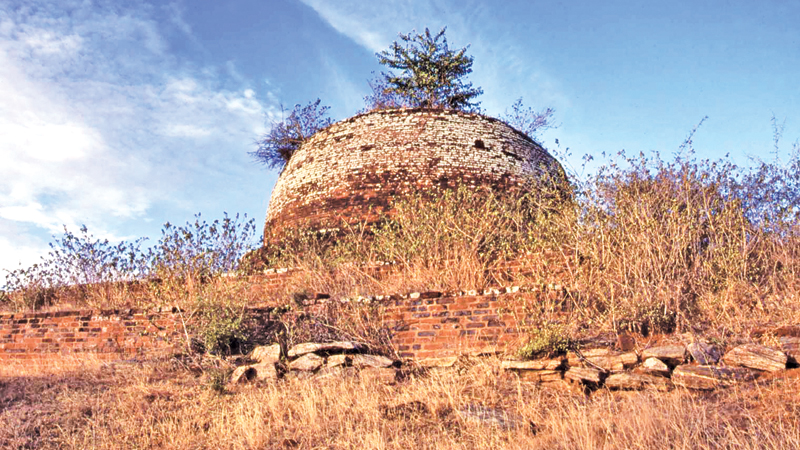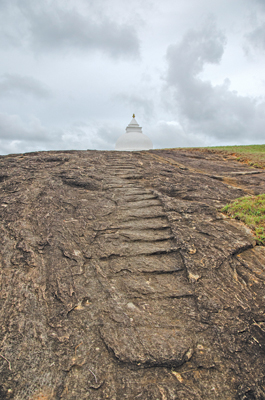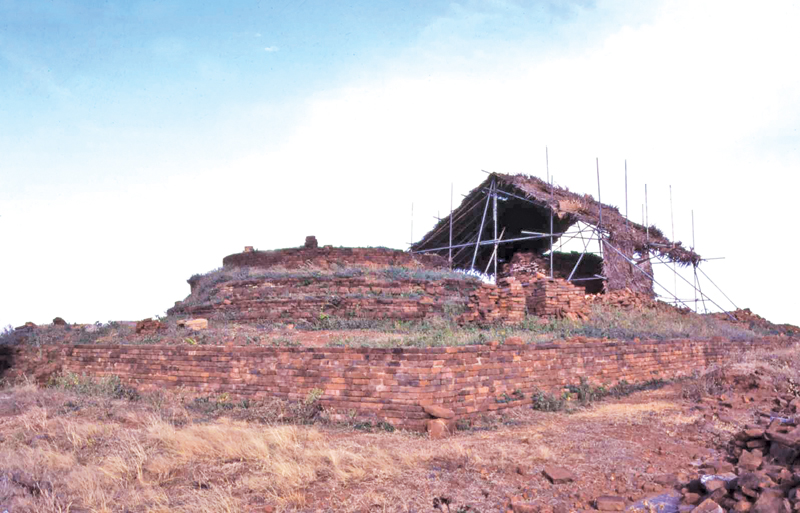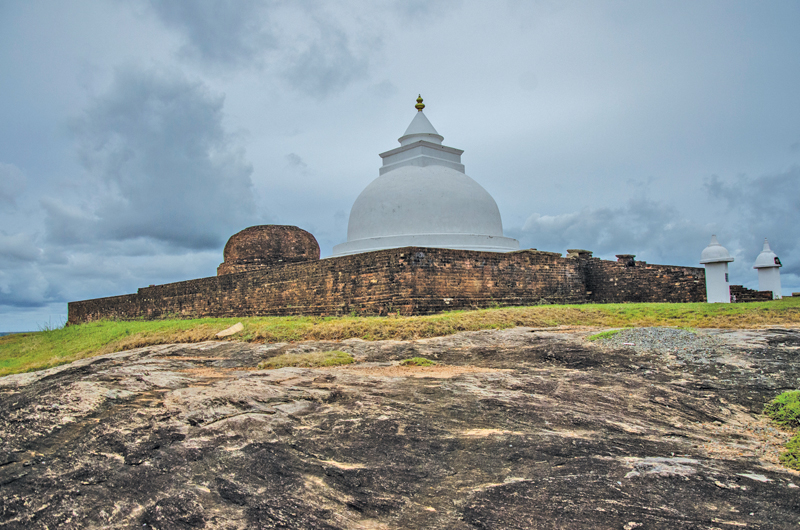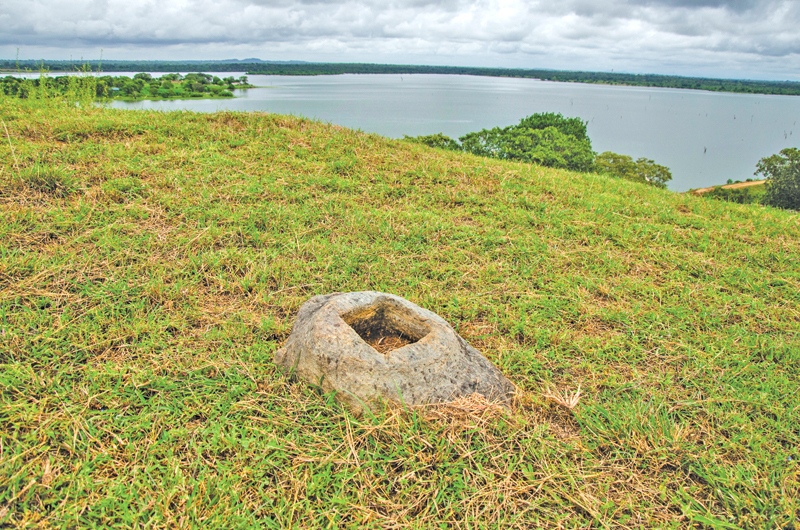Abode of Arahats-by Mahil Wijesinghe
Source:Sundayobserver
The Yahangala stupa is at the top of a rock, 14kms from Hambantota-Badagiriya road. The temple dates from the Anuradhapura period (3rd Century BC to 11th Century AD). Two inscriptions found at this site written in the early Brahmi script of the 2nd Century BC mention about donations made to the monastery, which helps to date the construction of the monastery. At the foot of the rock, there are ruins of three small stupas. The Archaeology Department has conserved one of them, while the others have yet to be conserved
Yahangala off the 155th mile post (on the Colombo-Galle-Matara-Hambantota-Tissamaharama road), lies on a road leading to the Badagiriya colonisation scheme, where a wealth of archaeological ruins and ancient Dagabas have been brought to light. This turn off is at Pallemala and is about 16 kilometres from Hambantota.
About 20 kilometres on the same stretch of roadway leading to Yahangala which also runs through rice fields and peasants’ houses is another valuable haven of archaeological and historical interest quite reminiscent of the ancient concept of the tank, (wewa), dagaba, rice field (keth yaya). Here lies another museum of a forgotten heritage comprising another Vihara perched separately on a twin rock outcrop.
I first visited Yahangala in 2003 and Yahangala was not so developed. Yahangala, the reclining rock (for all visual purposes it looks so), which is believed to have been the hallowed abode of Arahats (Buddhist sages). The shape of this Dagaba is unique and quite striking.
In archaeological terms, when referring to the shape of Dagabas, it takes the shape of a Bibula – a bubble shaped Dagaba. Steps have been carved on the rock itself coming down from ancient times. But one must be cautious in stepping on them, as the steps have worn out. Atop Yahangala one is able to have an imposing view of the whole landscape. On its Western flank is the vast ocean, while on its Southwestern side lies Malala Kalapuwa.
Inscriptions
The Yahangala stupa is at the top of a rock, 14kms from the Hambantota-Badagiriya road. The temple dates from the Anuradhapura period (3rd Century BC to 11th Century AD). Two inscriptions found at the site written in the early Brahmi script of the 2nd Century BC mention about donations to the monastery, which helps to date the construction of the monastery. At the foot of the rock, there are ruins of three small stupas. The Archaeology Department has conserved one of them, while the others have yet to be conserved.
These stupas are quite small, similar to the small stupas built for the remains of bhikkhus. The reason for building three small stupas is yet not clear. A flight of steps helps to make one’s way up to the summit where the pools were constructed and many people of the area, including the bhikkhus who live below the rock today, use these pools for their daily needs, especially during the dry season.
There are also a few clusters of pillars indicating that there were solid structures during ancient times. This ancient temple was probably an important monastery in Ruhuna during its heyday. The extent of the monastery was quite large as indicated by the brick debris and other evidence that could still be found around the rock.
Like most temples in this region, Yahangala monastery also rapidly declined with the moving of the capital city to the wet zone of Sri Lanka. It was discovered during colonisation schemes of the 20th century. The other chaitya known as Badagiriya perched on twin rock outcrop having two separate dagabas is also visible, while on the far Eastern side lie profiles of the sacred hills of Kataragama.
This ancient site of the Badagiriya Chaitya is vaulted by coconut and groves of forest trees. A huge Bo tree towers over the foot of this rock like tower where stands the modern Avasa (Bhikkhu’s residence) of the temple. A limestone Buddha statue and other sculptured stone figures unearthed at this site are kept under the spreading bowers of this giant Bo tree.
Development and restoration
I had visited the Badagiriya temple in 2003, when I paid a visit to Yahangala which also lies close to Badagiriya. Much development and restoration has taken place since those past years. In my first trip, I saw restoration work of the bricks stupa on the summit of the Badagiriya rock boulder.
The stupa on the rock was in ruins exposing its ancient bricks strewn everywhere. The stupa has the shape of a Danya, meaning in the form of stacked sheaves of paddy. It is covered with a scrub jungle. On its other contiguous rock boulder is the Vihara, a mound of broken bricks has lived to tell its past glorious existence.
There was a plain Sadakada Pahana (moonstone, half of the lotus flower was featured on this stone slab).
In my resent visit, I saw all the ruins and ancient stupa were restored by the Department of Archaeology and white creamy Badagiriya Chaitya and brick-built stupa visible on the summit in the backdrop of the Badagiriya tank.
Rock carved stone steps were still observed on the rock outcrop coming down from ancient times. There is a rock shoulder with a lid at the summit, hence it is called Pian Pokuna (a pond with a lid). Mal Asana are commonly known as flower altars, but these are not so; these stone slabs squares are called in archaeological terms Asana Gharas which were objects of veneration by ancient Buddhists before the Buddha statues were introduced. Its base was not well mounded, and quite uneven. Both the Vehera and Vihara were dug out by treasure hunters.
Overlooking this Badagiriya Chaitya lies its vast tank also called the Badagiriya tank. Its tank is filled with the waters of the Malala ara. The tank was restored in 1958 and farmers were settled on irrigable and homestead lots. (It was across the Malala Ara that the Badagiriya tank was built in ancient times.)
On the heights of the Badagiriya rock, one could have a bird’s eye view of the Karambagala Aranya lying in the Walawe region occupying the Southeast quarter and the newly built Mattala Mahinda Rajapaksa International Airport on the West. At the base of the rock boulder were some faint Brahmi inscriptions.
Dr. R. L. Brohier’s description
Dr. R. L. Brohier in his ‘Ancient Irrigation Works’, Part III, gives the following description of this Badagiriya rock, Chaitya and its tank: “To the East of the high road from Hambantota to Badulla, there is a large and a remarkable rock standing high above the plains and surmounted by the ruins of two Dagabas. A long flight of steps partially worn out leads to the top. On the shoulder of this rock of Badagiriya, there are several curious water holes (kemas) apparently of artificial construction.
“At the base of the Badagiriya rock, on its Northern side flows Mallala Oya which takes its rise in the Dawagiri hills, though often dry in the hot season, pours down at flood times, a large volume of fresh water to form a drainage area of 135 sq. miles. The stream finds its way in the Mallala Oya was forced to render great service to the country in ancient times is told by breached bund extending from the foot of Badagiriya rock nearly two miles Northwards across the valley of the Mallala Oya. This ancient embankment stored up the flood waters of the stream submerged 2,000 acres of land and three half round it, a liquid contour said to have extended seven miles above the ancient anicut.”
That was a graphic eye witness account of the Badagiriya tank and the ancient dagabas, how they had stood among its ruins by Dr. Brohier before the tank was restored in 1958. In folk-tale, it is told by villagers that Malala Oya means Mala – dead Oya/stream giving the inference that it grows dry and that is so during the dry season. But this meaning may not hold water, considering the account given by Dr. Brohier in his books on ancient irrigation tanks.
It is said once upon a time in those grand old days of Ruhunu Rata, vast stretches of land now occupied by the Malala lagoon there had been flourishing rice fields that had stretched the bounteous Malala valley, far and wide.


